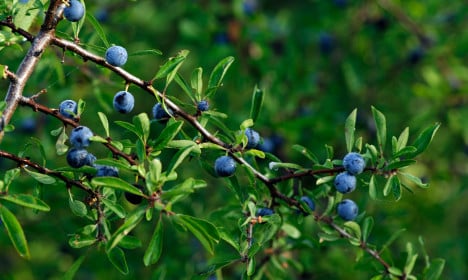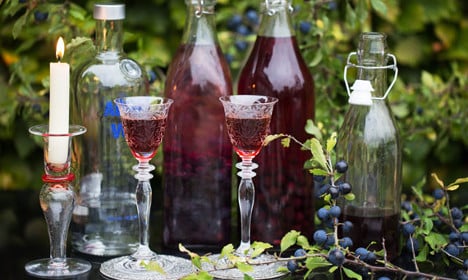Slånbärssnaps (sloe snaps) is a popular type of snaps that Swedes like to make at home in the autumn, so that it is ready for Christmas. Sloes are the fruit of the blackthorn, one of the very first bushes to flower in the spring. They are extremely tart when they first ripen in October, but winter frosts mellow their taste to give them a rich almondy sourness.
Traditionally therefore, sloes were not picked until after the first heavy frost of the autumn. However, most people now pick them earlier and pop them into the freezer for a couple of days instead.
Summary
Makes: 1 bottle
Preparation: 15 minutes (spread over two months)
Ingredients
½ bottle ripe sloes
2 tbsp caster (superfine) sugar
1 bottle unflavoured vodka or brännvin

Sloe berries are a great addition to snaps. Photo: Hasse Holmberg/TT
Method
1. Pick over the sloes and remove all stems (if they need rinsing, leave them to dry in the shade on paper towels).
2. Freeze them for at least two days.
3. Add the sugar to a sterilized glass jar or bottle with a tight fitting lid and then half fill with frozen sloes.
4. Fill up the bottle with clear, unflavoured vodka or Swedish 'brännvin'.
5. Lay the bottle on its side in a dark place at room temperature, turning it through 180C every couple of days for at least four weeks, preferably eight weeks (you can shake the bottles every two days if you prefer).
6. Have a taste and look at the bottle to decide on what to do next. There are three possibilities:
a) it may be perfect as it is, in which you can leave it with the sloes in the bottle for the flavours to mature
b) if it is cloudy or has sediment then filter it through muslin into a new sterilized bottle (it may need filtering more than once)
c) it may need sweetening, in which case heat equal quantities of sugar and water until the sugar dissolves. Leave the sugar solution to cool and then add a teaspoon at a time to the slånbärssnaps until it is sweet enough
7. Store in the dark at room temperature until required.
Tips
– Make sure the sloes are ripe. They should give slightly if squeezed.
– Make the snaps in a bottle or jar with a wide neck or the sloes will get stuck in the bottle.
– Serve slånbärssnaps at room temperature and remember to keep your bottle tightly closed and in a dark place before and between servings.
– Unlike many other snaps flavourings, the sloes can be left in the bottle and in time the almond flavour from the stones will penetrate the drink and make it even better. But most people drink it before that happens.
This recipe was originally published on food writer John Duxbury's website Swedish Food. Here's another one of his best snaps recipes



 Please whitelist us to continue reading.
Please whitelist us to continue reading.